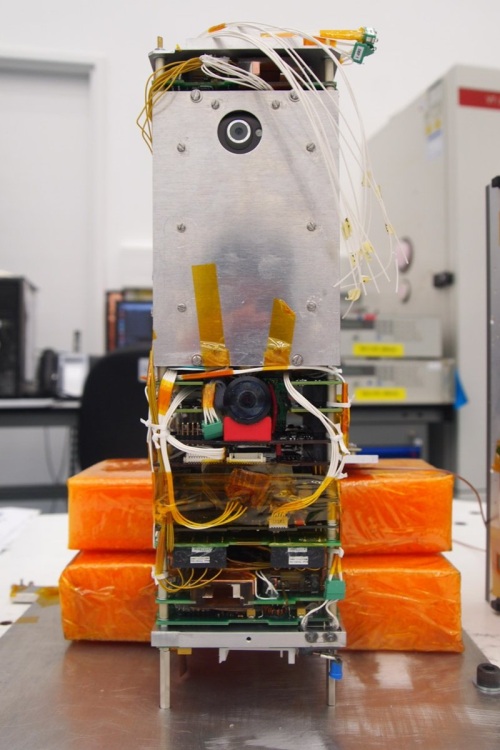A nanosatellite equipped with a smartphone was successfully launched into space from India on February 25. I don’t just mean pieces of a phone. The whole cellphone is actually flying out in space with the phone’s camera peeping out through a “porthole.” The satellite’s creator, a U.K.-based company called Surrey Sateliite Technology (SST), has named it STRaND-1, and it is the first ever smartphone to orbit in space.

The STRaND-1 satellite, incomplete. Notice the smartphone's camera peeping through its front hole. (Image via SST)
However, this is not the first time a group has attempted to put smartphones into space. There have been cases where smartphones were placed onto high-altitude helium-filled weather balloons, but just flew very high in the atmosphere, never making it into space. Smartphones have even floated inside the International Space Station, but were controlled by humans, therefore were not subjected to the harsh conditions of space.
SST chose to launch the Google Nexus One smartphone since it runs on the user-friendly Android operating system, is cheap, and was easily available when they began the project in 2011.
The satellite weighs just less than 10 lbs. and, according to SST, “as a whole will cost only slightly more than a high-end family car.”
Features
STRaND-1 is part of the 3U CubeSat training and demonstration mission to test commercial off-the-shelf technologies in space. Some of the new technology featured on the satellite includes a new Linux-based high-speed processor, an altitude and orbital control system, two new propulsion systems, and even some 3D-printed parts. The propulsion systems comprise eight electric pulsed plasma thrusters and a WARP DRiVE (Water Alcohol Resistojet Propulsion Deorbit Re-entry Velocity Experiment) that will deorbit the satellite at the end of its journey.
The on-board computer will even monitor the temperature of the phone’s battery. If it sees it is getting too cold, it will trigger a processor program on the phone that will warm its battery.

The finished STRaND-1 satellite ready to orbit, along with team members from SST. (Image via SST)
Apps
Your smartphone wouldn’t be complete without some apps. Neither would STRaND-1. SST incorporated apps that were developed by winners of a Facebook competition last year. The company didn’t include only serious apps for data collection, but also some fun ones that engage the public. Some of the apps uploaded onto the phone include:
- 360 app. The app is designed to take pictures using the smartphone’s camera and uses on-board technology to establish STRaND’s position. You can even request your own unique satellite image of earth, just click here.
- Scream in Space app. This app was actually developed by Cambridge University Space Flight and will make use of the speakers on the smartphone. The idea for this app came from the 1979 movie “Alien,” testing the theory that no one can hear you scream in space. Screams will be recorded using the smartphone’s own microphone, and the app will play videos of the best screams while in orbit. Visit the scream in space website to record your scream and send it to space.
Track the satellite
STRaND-1 carries an amateur radio 9,600-bit/s AX.25 radio downlink on 437.568 MHz. So, if you want to be a part of the mission, you can. SST invites radio amateurs to track STRaND-1. To find out more about the downlink frequency, visit the AMSAT-UK website.
Advertisement





